[English] 日本語
 Yorodumi
Yorodumi- PDB-1m11: structural model of human decay-accelerating factor bound to echo... -
+ Open data
Open data
- Basic information
Basic information
| Entry | Database: PDB / ID: 1m11 | ||||||
|---|---|---|---|---|---|---|---|
| Title | structural model of human decay-accelerating factor bound to echovirus 7 from cryo-electron microscopy | ||||||
 Components Components |
| ||||||
 Keywords Keywords | Virus/Receptor /  decay-accelerating factor / SCR / Icosahedral virus / Virus-Receptor COMPLEX decay-accelerating factor / SCR / Icosahedral virus / Virus-Receptor COMPLEX | ||||||
| Function / homology |  Function and homology information Function and homology informationnegative regulation of complement activation / regulation of lipopolysaccharide-mediated signaling pathway /  regulation of complement-dependent cytotoxicity / regulation of complement-dependent cytotoxicity /  regulation of complement activation / RNA-protein covalent cross-linking / regulation of complement activation / RNA-protein covalent cross-linking /  respiratory burst / respiratory burst /  : / positive regulation of CD4-positive, alpha-beta T cell activation / positive regulation of CD4-positive, alpha-beta T cell proliferation / Class B/2 (Secretin family receptors) ...negative regulation of complement activation / regulation of lipopolysaccharide-mediated signaling pathway / : / positive regulation of CD4-positive, alpha-beta T cell activation / positive regulation of CD4-positive, alpha-beta T cell proliferation / Class B/2 (Secretin family receptors) ...negative regulation of complement activation / regulation of lipopolysaccharide-mediated signaling pathway /  regulation of complement-dependent cytotoxicity / regulation of complement-dependent cytotoxicity /  regulation of complement activation / RNA-protein covalent cross-linking / regulation of complement activation / RNA-protein covalent cross-linking /  respiratory burst / respiratory burst /  : / positive regulation of CD4-positive, alpha-beta T cell activation / positive regulation of CD4-positive, alpha-beta T cell proliferation / Class B/2 (Secretin family receptors) / symbiont-mediated suppression of host cytoplasmic pattern recognition receptor signaling pathway via inhibition of RIG-I activity / ficolin-1-rich granule membrane / side of membrane / COPI-mediated anterograde transport / : / positive regulation of CD4-positive, alpha-beta T cell activation / positive regulation of CD4-positive, alpha-beta T cell proliferation / Class B/2 (Secretin family receptors) / symbiont-mediated suppression of host cytoplasmic pattern recognition receptor signaling pathway via inhibition of RIG-I activity / ficolin-1-rich granule membrane / side of membrane / COPI-mediated anterograde transport /  complement activation, classical pathway / complement activation, classical pathway /  transport vesicle / transport vesicle /  picornain 2A / symbiont-mediated suppression of host mRNA export from nucleus / symbiont genome entry into host cell via pore formation in plasma membrane / endoplasmic reticulum-Golgi intermediate compartment membrane / picornain 2A / symbiont-mediated suppression of host mRNA export from nucleus / symbiont genome entry into host cell via pore formation in plasma membrane / endoplasmic reticulum-Golgi intermediate compartment membrane /  picornain 3C / T=pseudo3 icosahedral viral capsid / secretory granule membrane / host cell cytoplasmic vesicle membrane / picornain 3C / T=pseudo3 icosahedral viral capsid / secretory granule membrane / host cell cytoplasmic vesicle membrane /  Regulation of Complement cascade / endocytosis involved in viral entry into host cell / cytoplasmic vesicle membrane / positive regulation of T cell cytokine production / Regulation of Complement cascade / endocytosis involved in viral entry into host cell / cytoplasmic vesicle membrane / positive regulation of T cell cytokine production /  : / nucleoside-triphosphate phosphatase / protein complex oligomerization / virus receptor activity / monoatomic ion channel activity / positive regulation of cytosolic calcium ion concentration / : / nucleoside-triphosphate phosphatase / protein complex oligomerization / virus receptor activity / monoatomic ion channel activity / positive regulation of cytosolic calcium ion concentration /  RNA helicase activity / RNA helicase activity /  DNA replication / induction by virus of host autophagy / DNA replication / induction by virus of host autophagy /  RNA-directed RNA polymerase / RNA-directed RNA polymerase /  membrane raft / symbiont-mediated suppression of host gene expression / viral RNA genome replication / cysteine-type endopeptidase activity / membrane raft / symbiont-mediated suppression of host gene expression / viral RNA genome replication / cysteine-type endopeptidase activity /  RNA-dependent RNA polymerase activity / RNA-dependent RNA polymerase activity /  Golgi membrane / Golgi membrane /  innate immune response / DNA-templated transcription / innate immune response / DNA-templated transcription /  lipid binding / host cell nucleus / Neutrophil degranulation / structural molecule activity / virion attachment to host cell / lipid binding / host cell nucleus / Neutrophil degranulation / structural molecule activity / virion attachment to host cell /  cell surface / cell surface /  RNA binding / extracellular exosome / extracellular region / RNA binding / extracellular exosome / extracellular region /  ATP binding / ATP binding /  metal ion binding / metal ion binding /  nucleus / nucleus /  plasma membrane plasma membraneSimilarity search - Function | ||||||
| Biological species |   Homo sapiens (human) Homo sapiens (human)  Human echovirus 7 Human echovirus 7 | ||||||
| Method |  ELECTRON MICROSCOPY / ELECTRON MICROSCOPY /  single particle reconstruction / single particle reconstruction /  cryo EM / Resolution: 16 Å cryo EM / Resolution: 16 Å | ||||||
 Authors Authors | He, Y. / Lin, F. / Chipman, P.R. / Bator, C.M. / Baker, T.S. / Shoham, M. / Kuhn, R.J. / Medof, M.E. / Rossmann, M.G. | ||||||
 Citation Citation |  Journal: Proc Natl Acad Sci U S A / Year: 2002 Journal: Proc Natl Acad Sci U S A / Year: 2002Title: Structure of decay-accelerating factor bound to echovirus 7: a virus-receptor complex. Authors: Yongning He / Feng Lin / Paul R Chipman / Carol M Bator / Timothy S Baker / Menachem Shoham / Richard J Kuhn / M Edward Medof / Michael G Rossmann /  Abstract: Echoviruses are enteroviruses that belong to Picornaviridae. Many echoviruses use decay-accelerating factor (DAF) as their cellular receptor. DAF is a glycosylphosphatidyl inositol-anchored ...Echoviruses are enteroviruses that belong to Picornaviridae. Many echoviruses use decay-accelerating factor (DAF) as their cellular receptor. DAF is a glycosylphosphatidyl inositol-anchored complement regulatory protein found on most cell surfaces. It functions to protect cells from complement attack. The cryo-electron microscopy reconstructions of echovirus 7 complexed with DAF show that the DAF-binding regions are located close to the icosahedral twofold axes, in contrast to other enterovirus complexes where the viral canyon is the receptor binding site. This novel receptor binding position suggests that DAF is important for the attachment of viral particles to host cells, but probably not for initiating viral uncoating, as is the case with canyon-binding receptors. Thus, a different cell entry mechanism must be used for enteroviruses that bind DAF. | ||||||
| History |
|
- Structure visualization
Structure visualization
| Movie |
 Movie viewer Movie viewer |
|---|---|
| Structure viewer | Molecule:  Molmil Molmil Jmol/JSmol Jmol/JSmol |
- Downloads & links
Downloads & links
- Download
Download
| PDBx/mmCIF format |  1m11.cif.gz 1m11.cif.gz | 46.6 KB | Display |  PDBx/mmCIF format PDBx/mmCIF format |
|---|---|---|---|---|
| PDB format |  pdb1m11.ent.gz pdb1m11.ent.gz | 23.8 KB | Display |  PDB format PDB format |
| PDBx/mmJSON format |  1m11.json.gz 1m11.json.gz | Tree view |  PDBx/mmJSON format PDBx/mmJSON format | |
| Others |  Other downloads Other downloads |
-Validation report
| Arichive directory |  https://data.pdbj.org/pub/pdb/validation_reports/m1/1m11 https://data.pdbj.org/pub/pdb/validation_reports/m1/1m11 ftp://data.pdbj.org/pub/pdb/validation_reports/m1/1m11 ftp://data.pdbj.org/pub/pdb/validation_reports/m1/1m11 | HTTPS FTP |
|---|
-Related structure data
| Related structure data |  1g40 |
|---|---|
| Similar structure data |
- Links
Links
- Assembly
Assembly
| Deposited unit | 
|
|---|---|
| 1 | x 60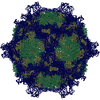
|
| 2 |
|
| 3 | x 5
|
| 4 | x 6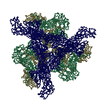
|
| 5 | 
|
| Symmetry | Point symmetry: (Hermann–Mauguin notation : 532 / Schoenflies symbol : 532 / Schoenflies symbol : I (icosahedral : I (icosahedral )) )) |
- Components
Components
| #1: Protein |  / Coordinate model: Cα atoms only / Coordinate model: Cα atoms onlyMass: 27017.299 Da / Num. of mol.: 1 / Fragment: four SCR domains 1 to 4 Source method: isolated from a genetically manipulated source Source: (gene. exp.)   Homo sapiens (human) / Production host: Homo sapiens (human) / Production host:   Pichia pastoris (fungus) / References: UniProt: P08174 Pichia pastoris (fungus) / References: UniProt: P08174 |
|---|---|
| #2: Protein | Mass: 31682.414 Da / Num. of mol.: 1 Source method: isolated from a genetically manipulated source Source: (gene. exp.)   Human echovirus 7 / Genus: Enterovirus Human echovirus 7 / Genus: Enterovirus / Species: Human enterovirus B / Description: RHABDOMYOSARCOMA CELL (RD); / Cell line (production host): RD / Production host: / Species: Human enterovirus B / Description: RHABDOMYOSARCOMA CELL (RD); / Cell line (production host): RD / Production host:   Homo sapiens (human) / Tissue (production host): muscle / References: UniProt: Q914E0 Homo sapiens (human) / Tissue (production host): muscle / References: UniProt: Q914E0 |
| #3: Protein | Mass: 28443.154 Da / Num. of mol.: 1 Source method: isolated from a genetically manipulated source Source: (gene. exp.)   Human echovirus 7 / Genus: Enterovirus Human echovirus 7 / Genus: Enterovirus / Species: Human enterovirus B / Description: RHABDOMYOSARCOMA CELL (RD); / Cell line (production host): RD / Production host: / Species: Human enterovirus B / Description: RHABDOMYOSARCOMA CELL (RD); / Cell line (production host): RD / Production host:   Homo sapiens (human) / Tissue (production host): muscle / References: UniProt: Q914E0 Homo sapiens (human) / Tissue (production host): muscle / References: UniProt: Q914E0 |
| #4: Protein | Mass: 26264.000 Da / Num. of mol.: 1 Source method: isolated from a genetically manipulated source Source: (gene. exp.)   Human echovirus 7 / Genus: Enterovirus Human echovirus 7 / Genus: Enterovirus / Species: Human enterovirus B / Description: RHABDOMYOSARCOMA CELL (RD) / Cell line (production host): RD / Production host: / Species: Human enterovirus B / Description: RHABDOMYOSARCOMA CELL (RD) / Cell line (production host): RD / Production host:   Homo sapiens (human) / Tissue (production host): muscle / References: UniProt: Q914E0 Homo sapiens (human) / Tissue (production host): muscle / References: UniProt: Q914E0 |
-Experimental details
-Experiment
| Experiment | Method:  ELECTRON MICROSCOPY ELECTRON MICROSCOPY |
|---|---|
| EM experiment | Aggregation state: PARTICLE / 3D reconstruction method:  single particle reconstruction single particle reconstruction |
- Sample preparation
Sample preparation
| Component | Name: human decay-accelerating factor, HUMAN ECHOVIRUS 7 COAT PROTEINS Type: VIRUS Details: This structure is modeled based on cryo-EM density at 16A resolution. |
|---|---|
| Buffer solution | Name: tris buffer pH7.5 / pH: 7.5 / Details: tris buffer pH7.5 |
| Specimen | Conc.: 8 mg/ml / Embedding applied: NO / Shadowing applied: NO / Staining applied : NO / Vitrification applied : NO / Vitrification applied : YES : YES |
Vitrification | Details: SAMPLES WERE PREPARED AS THIN LAYERS OF VITREOUS ICE AND MAINTAINED AT NEAR LIQUID NITROGEN TEMPERATURE IN THE ELECTRON MICROSCOPE WITH A GATAN 626 CRYOTRANSFER HOLDER |
Crystal grow | *PLUS Method:  cryo-electron microscopy cryo-electron microscopy |
- Electron microscopy imaging
Electron microscopy imaging
| Microscopy | Model: FEI/PHILIPS CM300FEG/T / Date: Sep 10, 2001 |
|---|---|
| Electron gun | Electron source : :  FIELD EMISSION GUN / Accelerating voltage: 300 kV / Illumination mode: FLOOD BEAM FIELD EMISSION GUN / Accelerating voltage: 300 kV / Illumination mode: FLOOD BEAM |
| Electron lens | Mode: BRIGHT FIELD Bright-field microscopy / Nominal magnification: 45000 X / Nominal defocus max: 4200 nm / Nominal defocus min: 1800 nm Bright-field microscopy / Nominal magnification: 45000 X / Nominal defocus max: 4200 nm / Nominal defocus min: 1800 nm |
| Specimen holder | Temperature: 120 K |
| Image recording | Electron dose: 16.6 e/Å2 |
- Processing
Processing
| EM software |
| ||||||||||||||||||||||||||||
|---|---|---|---|---|---|---|---|---|---|---|---|---|---|---|---|---|---|---|---|---|---|---|---|---|---|---|---|---|---|
CTF correction | Details: CTF correction of each micrograph | ||||||||||||||||||||||||||||
| Symmetry | Point symmetry : I (icosahedral : I (icosahedral ) ) | ||||||||||||||||||||||||||||
3D reconstruction | Method: PFT / Resolution: 16 Å / Nominal pixel size: 3.11 Å Details: The echovirus 7 structure is unknown, the model used here is from coxsackievirus B3 (1COV) and echovirus 1 (1EV1).The DAF receptor model is from 1g40. Only CA coordinates are presented in the entry. Symmetry type: POINT | ||||||||||||||||||||||||||||
| Atomic model building | Space: REAL | ||||||||||||||||||||||||||||
| Atomic model building |
| ||||||||||||||||||||||||||||
| Refinement | Highest resolution: 16 Å | ||||||||||||||||||||||||||||
| Refinement step | Cycle: LAST / Highest resolution: 16 Å
|
 Movie
Movie Controller
Controller


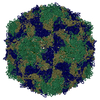



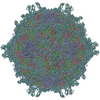

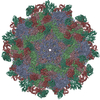


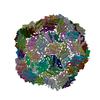
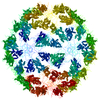
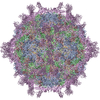
 PDBj
PDBj






